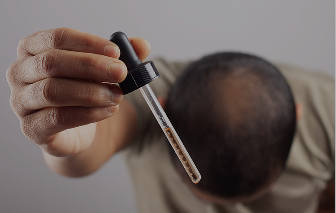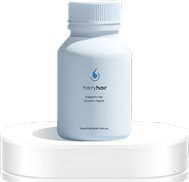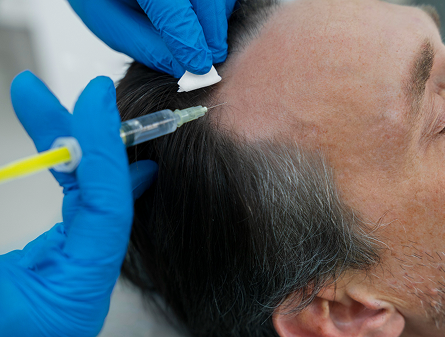Minoxidil is a hair loss treatment that works as a vasodilator. By increasing the blood circulation to the scalp through dilated blood vessels, hair follicles become larger and can receive more oxygen and nutrients for healthier growth. Dutasteride is a treatment for pattern hair loss that works as a dihydrotestosterone (DHT) blocker.
By lowering the levels of DHT in the body, hair follicles can grow healthily without being miniaturised. Minoxidil is typically a topical treatment that is used to stimulate hair growth. Dutasteride is usually taken as an oral medication to prevent hair follicles from shrinking becoming weakened and brittle.
Check out the comparison table below to see if minoxidil or dutasteride is your best treatment choice.
- Minoxidil is an over-the-counter topical preparation that stimulates hair growth by increasing blood supply to the scalp.
- Unlike dutasteride, it is locally active on the scalp and suitable for both female and male populations.
- Dutasteride is an oral prescribed medication that blocks DHT more than finasteride.
- Unlike minoxidil, it works against hair loss in a systemic way and is presently used off-label in Australia for this very reason.
- Minoxidil costs approximately $20–$50 per month and is purchased without a prescription.
- Unlike dutasteride, the cost is lower upfront but increases over continuous long-term use.
- Dutasteride is more expensive per tablet than Finasteride and requires a doctor’s prescription.
- It may cost more initially than minoxidil, but it could offer stronger results for some users.
- Minoxidil must be used once or twice daily indefinitely.
- Results begin to show in 3–6 months but regress quickly if stopped.
- Dutasteride is taken daily and shows results over 3–6 months.
- Unlike minoxidil, it maintains progress more steadily if doses are missed occasionally.
- Minoxidil is applied directly to the scalp to stimulate follicle activity externally.
- It doesn’t affect hormone levels like dutasteride does.
- Dutasteride inhibits type I, II and III 5-alpha reductase enzymes to lower DHT levels.
- Unlike minoxidil, it works internally by altering hormonal pathways.
- Minoxidil is generally safe but may cause skin irritation, flaking, or unwanted hair growth on the face.
- Safer than dutasteride for those avoiding systemic side effects.
- Dutasteride may cause side effects like decreased libido, erectile dysfunction, or mood changes.
- Unlike minoxidil, it has a higher risk profile due to its hormonal mechanism.
- Minoxidil needs daily topical application, which can be time-consuming.
- It demands more labour compared to dutasteride.
- Dutasteride is administered as a once-daily tablet, less cumbersome than that of minoxidil.
- Ideal for individuals desiring low-care oral routines.
- Minoxidil is available for purchase at pharmacies and online throughout Australia.
- Easier to access than dutasteride, which requires a prescription.
- Dutasteride is only prescribed and used off-label in Australia for hair loss.
- Unlike minoxidil, it must be obtained through a healthcare provider.
- Minoxidil results decline quickly if treatment is stopped.
- Requires lifelong daily use to sustain progress.
- Dutasteride results tend to taper more gradually after discontinuation.
- Compared to minoxidil, it offers slightly more lasting effects when use is interrupted.
- Minoxidil is often combined with oral treatments like dutasteride.
- It can enhance regrowth when used alongside systemic DHT blockers.
- Dutasteride is commonly used with topical minoxidil for a comprehensive approach.
- Unlike minoxidil, it targets the hormonal root cause of hair loss internally.
- Minoxidil appeals to users wanting a visible, non-invasive approach.
- Offers more immediate control over the application and progress.
- Dutasteride appeals to users who want a powerful, science-backed internal solution.
- Unlike minoxidil, it’s viewed as a more decisive long-term intervention for genetic hair loss.
- Minoxidil boosts circulation at the scalp and supports follicular activity.
- It doesn’t interfere with hormones like dutasteride does.
- Dutasteride blocks DHT formation, which helps preserve hair in men with androgenetic alopecia.
- Unlike minoxidil, it directly addresses hormonal contributors to hair loss.
- Minoxidil generates ongoing packaging waste due to monthly usage.
- Less environmentally friendly than one-time oral packaging.
- Dutasteride uses minimal monthly packaging and is more compact.
- Compared to minoxidil, it has a smaller environmental footprint.
Shop our hair solutions
We are committed to providing affordable hair regeneration services for people all over Australia. Our formula can help you regain your confidence.
Shop Now

Minoxidil vs Dutasteride Treatment Comparison Summary
Minoxidil is a highly effective solution for hair loss which has been approved by medical boards such as the FDA. Dutasteride is also an effective hair loss treatment for androgenic alopecia but is only approved for use in Japan and South Korea. Minoxidil can be acquired over the counter but comes at a higher cost, it can also be prescribed to you at a lower price.
Dutasteride can be prescribed off-label at a comparatively lower price, but it may be difficult to find since it is a relatively new treatment. Minoxidil may be combined with other pharmaceutical and natural ingredients as part of oral hair loss treatments designed to tackle hair loss from multiple fronts.
Dutasteride is not typically combined in pill formulations but can be taken alongside other hair loss medications and treatments for effective results. Minoxidil should be started at the earliest sign of hair loss to be most effective.
Dutasteride is usually recommended if you have tried other DHT blockers like finasteride and have not seen results since dutasteride is a more potent solution that blocks all three types of isoenzymes responsible for the conversion of testosterone into DHT.
User Guidance
Minoxidil and dutasteride are designed to be long-term solutions to hair loss. If you stop using minoxidil, your results will reverse, and hair will quickly fall out again. Dutasteride works by irreversibly inhibiting the isoenzymes responsible for converting testosterone into DHT.
While new isoenzymes known as 5-alpha reductase can be produced, the indefinite binding means that results can be enjoyed for longer if stopped. Minoxidil typically comes with physical side effects as a topical solution such as itching, tingling and a rash at the application site.
Dutasteride carries more systemic side effects relating to sexual dysfunction, including loss of libido, erectile dysfunction and ejaculation issues.
Take Our Hair Loss Quiz to See Which Treatment Suits You?
Take A Hair Quiz

Frequently Asked Questions
We have put some commonly asked questions.
Nunc scelerisque tincidunt elit. Vestibulum non mi ipsum. Cras pretium suscipit tellus sit amet aliquet. Vestibulum maximus lacinia massa nontor.
Platelet-rich plasma (PRP) treatment involves drawing blood from the patient, isolating the beneficial nutrients and injecting it into the scalp where hair loss is occurring. This promotes hair growth and has many other applications from encouraging healing to skin rejuvenation.
Platelet-rich plasma (PRP) treatment involves drawing blood from the patient, isolating the beneficial nutrients and injecting it into the scalp where hair loss is occurring. This promotes hair growth and has many other applications from encouraging healing to skin rejuvenation.
Platelet-rich plasma (PRP) treatment involves drawing blood from the patient, isolating the beneficial nutrients and injecting it into the scalp where hair loss is occurring. This promotes hair growth and has many other applications from encouraging healing to skin rejuvenation.







 See All
See All